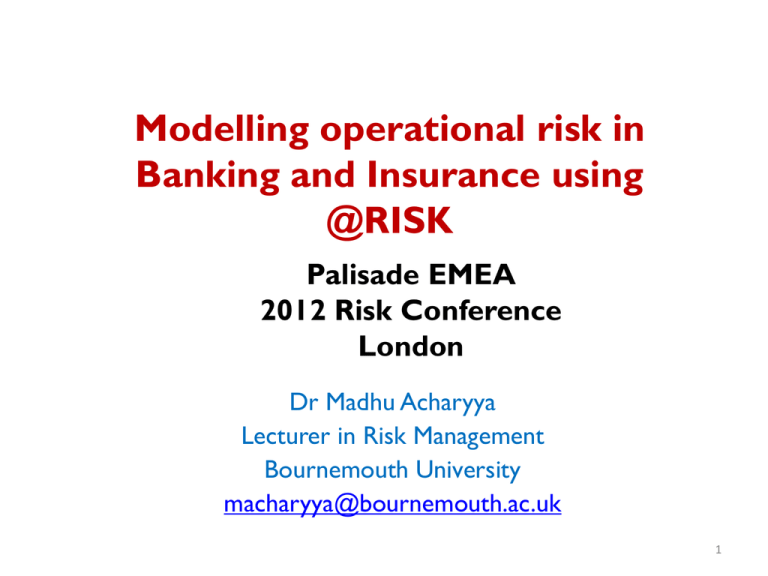Modelling operational risk in Banking and Insurance using @RISK
advertisement

Modelling operational risk in Banking and Insurance using @RISK Palisade EMEA 2012 Risk Conference London Dr Madhu Acharyya Lecturer in Risk Management Bournemouth University macharyya@bournemouth.ac.uk 1 Risks in Banking and Insurance Main Banking Risks Market risk Credit risk Liquidity risk Operational risk Systemic risk Strategic risk Reputational risk Main Insurance Risks Market risk Underwriting and pricing risk Credit risk Liquidity (reserving) risks Operational risk Strategic risk Reputational risk 2 Business Units/lines in Banking and Insurance Banking Credit department Banking book Derivative desk Fund management Others Insurance Underwriting department Personal and commercial Claims department Reinsurance department Finance and investment department Others 3 Credit department Credit department Banking book Banking book Derivative desk Derivative desk …… …… Fund management Fund management Operational risk ………. Credit Risk Business units Market Risk Risk types Interest Rate Risk Operational risk ………. Credit Risk Market Risk Business units Interest Rate Risk Risk types 4 Expected loss and Unexpected Loss Unexpected loss Expected loss Expected loss The mean value of the probability distribution of future losses. Not a significant risk and hedged by adding a suitable spread to the interest rate charged on the loan 5 Unexpected Loss The true risk i.e., the risk that the loss will prove greater than originally estimated • i.e., The variability of loss above the EL The EL of a diversified portfolio is simply equal to the sum of the expected losses on the individual loans in it • The EL is reduced by diversifying the portfolio The volatility of the total portfolio loss is generally lower than the sum of the volatilities of the losses on individual loans (provided that the correlations amongst the individual losses are low) where represents the individual credit losses 6 VaR computation Probability distribution of loss data Probability = 5% Minimum $ Loss Average $ Loss Maximum $ Loss 7 Three methods of calculating VaR 1. Parametric (or analytical or deltanormal) method 2. Historical method 3. Monte Carlo Simulation method 8 Example: Computation of Value at Risk (VaR) Year 1996 1997 Loss ($) 9223.41 9708.5 1998 1999 2000 11087.27 10059.5 8781.8 2001 2002 10106.58 11197.34 2003 2004 2005 2006 9892.56 9369.17 8842.99 10628.46 Minimum loss $8,781.80 Maximum loss $11,197.34 9 Mean Standard deviation $9,899.78 $826.76 Parametric approach for the standard normal distribution, z-statistic at 95% confidence interval VaR (95%) 1.645 $11,259.69 10 VaR computation Probability distribution of loss data Probability = 5% Minimum $ Loss $0 Average $ Loss $9,899.78 $11,259.69 VaR 95% Maximum $ Loss $ size of the portfolio 11 Interpretation of VaR Result Given the loss data the Bank or Insurance Company (or any of its business line) can afford a loss of maximum of $11,259.69. The bank or insurance company is 95% confident that the actual loss will remain within the boundary between $0 and $11,259.69. However, there is a 5% probability that the actual loss will go beyond $11,259.69. In other words, n every 1 in 20 occasions (or days/month/year) the actual loss will go above $11,295.69 If the actual loss goes above $11,295.69 then the bank or insurance company will be insolvent. 12 What is operational Risk Banking sector definition In Basel II the common industry definition of operational risk is – “The risk of direct or indirect loss resulting from inadequate or failed internal processes, people and systems or from external events.“ The definition includes legal risk but strategic and reputational risk is not included in this definition. Source: Basel Committee on Banking Supervision, Consultative Document, Operational Risk, January 2001, accessed at http://www.bis.org/publ/bcbsca07.pdf on 01st January, 2011 13 Insurance sector definition The Solvency II definition of operational risk is – “Operational risk means the risk of loss arising from inadequate or failed internal processes, or from personnel and systems, or from external events (Article 13(29) of Level 1 text). Operational risk shall include legal risks, and exclude risks arising from strategic decisions, as well as reputation risks (Article 101 4(f)) of the Level 1 text).” (Ref: CEIOPS Advice for Level 2 Implementing Measures on Solvency II: SCR Standard Formula – Article III (f) Operational risk: former CP53) 14 Table: Detailed loss event type classification in Insurance Operational Risk by ORIC Event categories Level 1 Level 2 Unauthorised activities Internal fraud Theft and fraud Level 3 1. Unauthorised used of computer system to defraud firm or customer 2. Unauthorised transactions 3. Underreported transactions 4. Over-reported transactions 5. Falsifying personal details 1. 2. 3. 4. 5. 6. Theft of assets Destruction of assets Forgery impersonation Disclosure of confidential information Accounting irregularities Misappropriation of assets 15 4. Theft of assets Forgery impersonation Fraudulent billing by suppliers Fraudulent claims System security 1. 2. 3. Hacking Theft of information Viruses Employee relations 1. 2. 3. 4. 5. Harassment Terminations, including tribunals Industrial activity Management Loss of key personnel Safe environment 1. 2. 3. Health and safety Public liability Employee liability Diversity and discrimination 1. 2. Equal opportunities Human rights External fraud 1. 2. 3. External fraud Employment practice and workplace safety 16 Suitability, disclosure and fiduciary 1. 2. 3. 4. 5. Improper business or market practices 2. 3. 4. Money laundering Other improper market practices Insider dealing Tax evasion Anti trust Product defects (unauthorised, etc.) Product literature defects Product design Unintentional guarantees Selection, sponsorship, and exposure 1. 2. Client fact-findings Client exposure Advisory activities 1. Mis-selling due to mortgage endowment Mis-selling (other) Clients, products and business practices Product flaws 1. 2. Regulatory impact Data protection act Regulatory compliance of appointed representatives Customer complaints Treating customers fairly 3. 4. 5. 1. 2. 17 Disasters and other events 1. Natural disaster losses 2. Loses from external sources (terrorism, vandalism) 3. Physical assets failure (not systems) Systems 1. 2. 3. 4. 5. 6. Damage to physical assets Business disruption and system failures Hardware Software IT network Telecommunication Utility outage/disruption External interference (excluding fraudulent activity) 18 Transaction capture, execution and maintenance 1. 2. 3. 4. Monitoring and reporting 1. 2. Failed mandatory reporting Inaccurate external reporting Customer intake and documentation 1. Incomplete/ incorrect application documents Contract document incorrect Inappropriate underwriting Inappropriate reinsurance Missing documentation Execution, delivery and process management Customer service failure Data entry error Transaction system error Management information error 5. Accounting error 6. Incorrect application of charges 7. Incorrect unit pricing/ allocation 8. Management failure 9. Inadequate process documentation 10. Training and competence 2. 3. 4. 5. Source: ORIC at http://www.abioric.com/oric-standards/risk-event-categories.aspx as on 29 Dec 2010. 19 Table: Summary of Operational Loss Data (All data are hypothetical) Internal Fraud Operational Risk Categories External Fraud Damage to Business Physical Assets Disruptions & System Failures No. of No. of Total No. of Total No. of Total No. of Total events Month no. of Month no. of Month no. of Month no. of per events events events events Month k n(k) n(k) n(k) n(k) 0 7 0 4 0 4 0 4 0 1 0 0 2 2 5 5 3 3 2 4 8 2 4 2 4 2 4 3 3 9 3 9 3 9 3 9 4 4 16 3 12 3 12 3 12 5 5 25 6 30 6 30 4 20 6 2 12 4 24 3 18 3 18 7 2 14 2 14 2 14 2 14 8 2 16 1 8 2 16 2 16 9 0 0 1 9 1 9 1 9 10 1 10 3 30 3 30 4 40 events 110 142 147 145 month 36 36 36 36 Average events 3.06 3.94 4.08 4.03 p/m (λ) Execution, Delivery & Process Management No. of Total Month no. of events n(k) 2 3 2 4 3 4 3 2 3 1 4 0 3 4 12 12 20 18 14 24 9 40 156 36 4.33 20 Table: Summary Statistics of Frequency Loss Data Internal Fraud Minimum ($) Maximum ($) Mean ($) Standard deviation ($) External Fraud Damage to Physical Assets Business Disruptio ns & System Failures Execution, Average Delivery & Process Managem ent 11,629.81 199,734.09 108,165.98 34,154.57 461,535.19 55,881.49 28,254.02 467,152.57 76,977.50 17,295.17 719,922.09 139,744.89 26,338.26 311,739.24 69,203.62 89,994.70 56,767.93 62,093.00 70,895.66 97,461.74 35,201.25 64,483.92 21 Table: Descriptive Statistics of Severity Loss Data Internal Fraud Minimum ($) Maximum ($) Mean ($) 11,629.81 199,734.09 108,165.98 External Fraud Damage to Physical Assets Business Disruptio ns & System Failures Executio Averag n, e Delivery & Process Managem ent 34,154.57 28,254.02 17,295.17 26,338.26 461,535.19 467,152.57 719,922.09 311,739.24 55,881.49 76,977.50 139,744.89 69,203.62 89,994.7 0 22 Table: Parameters of Loss Distributions from Aggregated Observed Loss Data Aggregated Operational Loss Parameters Distribution Type Frequency Mean=Variance 3.89 Poisson Severity Mean ($) 89,994.70 Pareto Standard deviation 64,483.92 ($) 23 Table: Parameters of Loss Distributions after Monte Carlo Simulation Aggregated Operational Loss Data Summary for Monte Carlo Simulation using @Risk Frequency 4.00 Severity ($) 64,484.632979 Total Aggregated 257,938.53 Operational Loss ($) 24 Figure: Monte Carlo Simulation Output for Internal Fraud Category 25 Figure: Monte Carlo Simulation Output for External Fraud Category 26 Figure: Monte Carlo Simulation Output for Damage to Physical Asset Category 27 Figure: Monte Carlo Simulation Output for Business Disruption and System Failures Category 28 Figure: Monte Carlo Simulation Output for Execution, Delivery and Process Management Category 29 Figure: Monte Carlo Simulation Output for Integrated Operational Risk 30 Irrational Human Behaviour Causing Operational (and Strategic) Failures Agency problem Principal-agent problem Intentional fraud Compensation culture Examples: 2007 Financial Crisis Lehman Brothers – over exposure on Securitised Products Royal Bank of Scotland – M&A with ABN AMRO Lloyd’s Banking Group – M&A with HBOS AIG – exposure on CDOs Many Others 31 Questions and Answers 32




